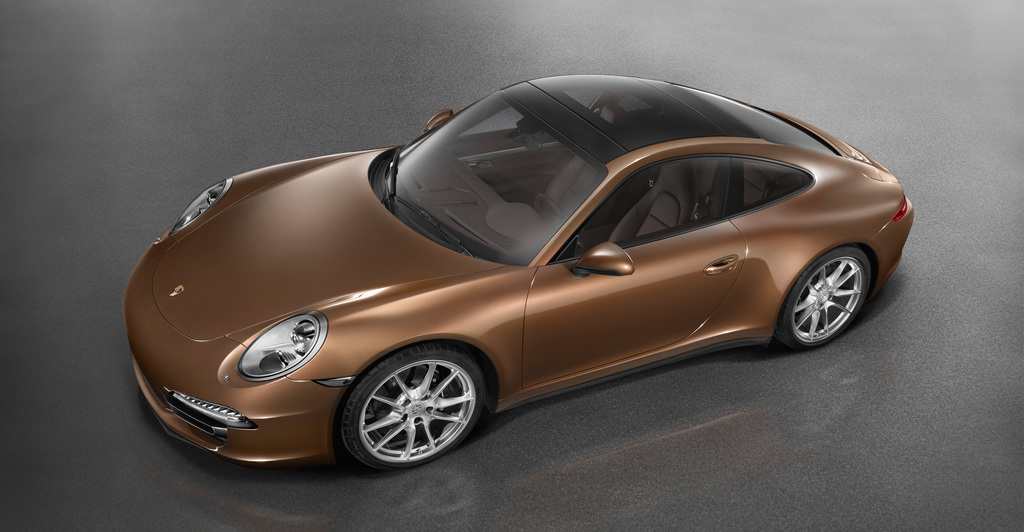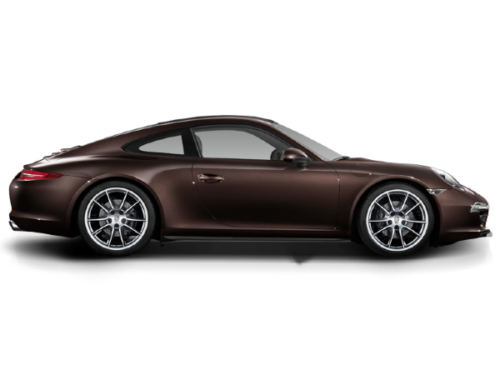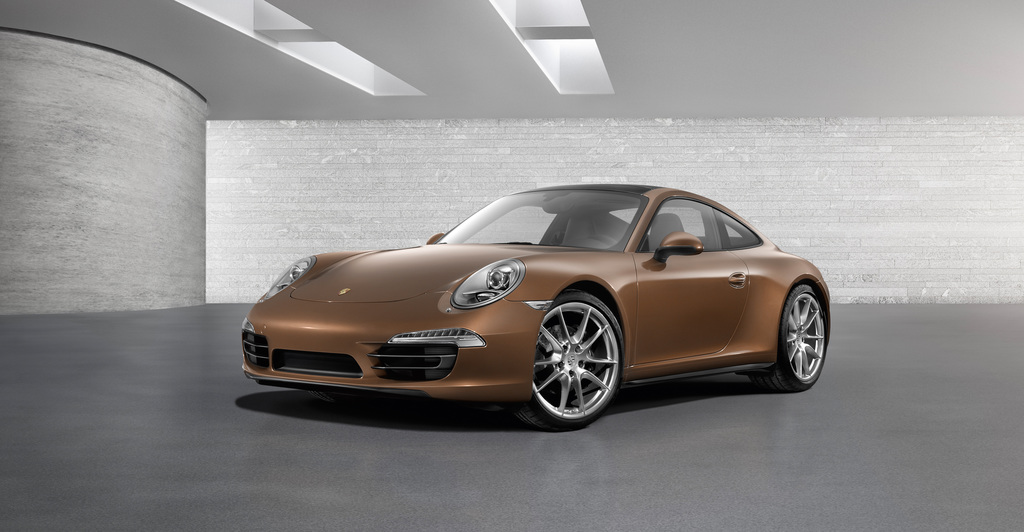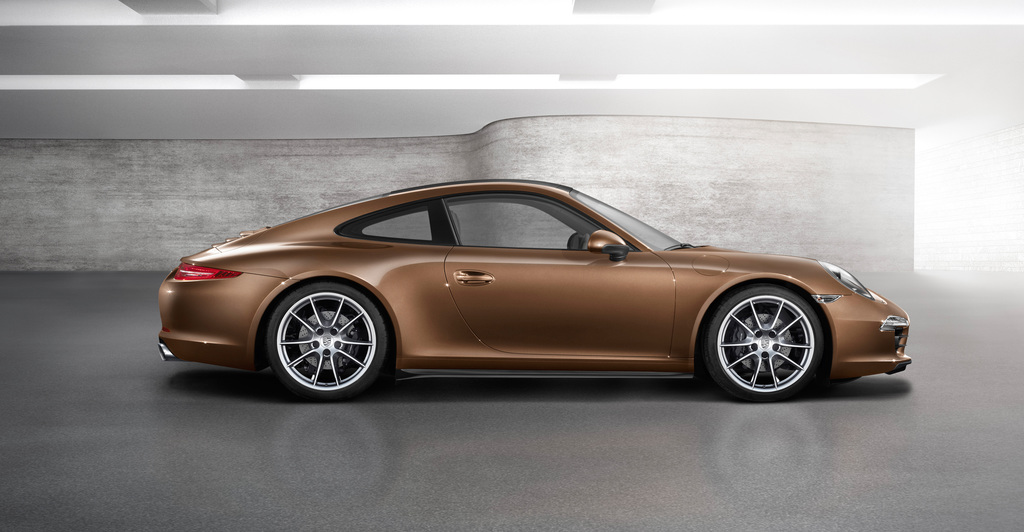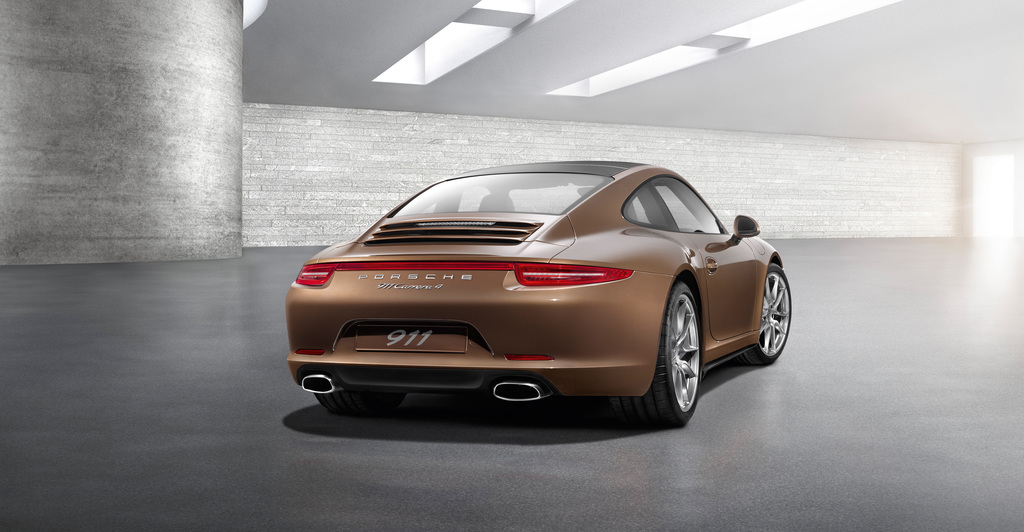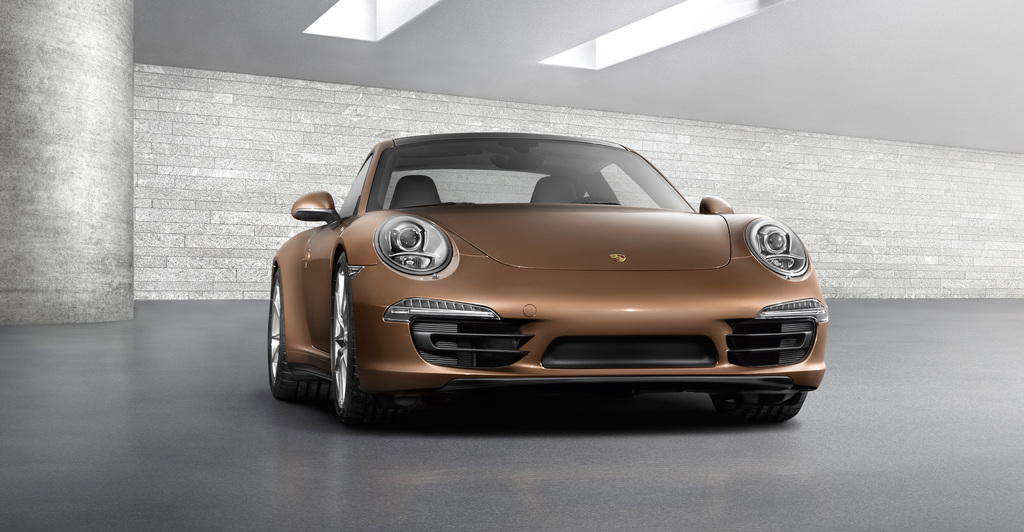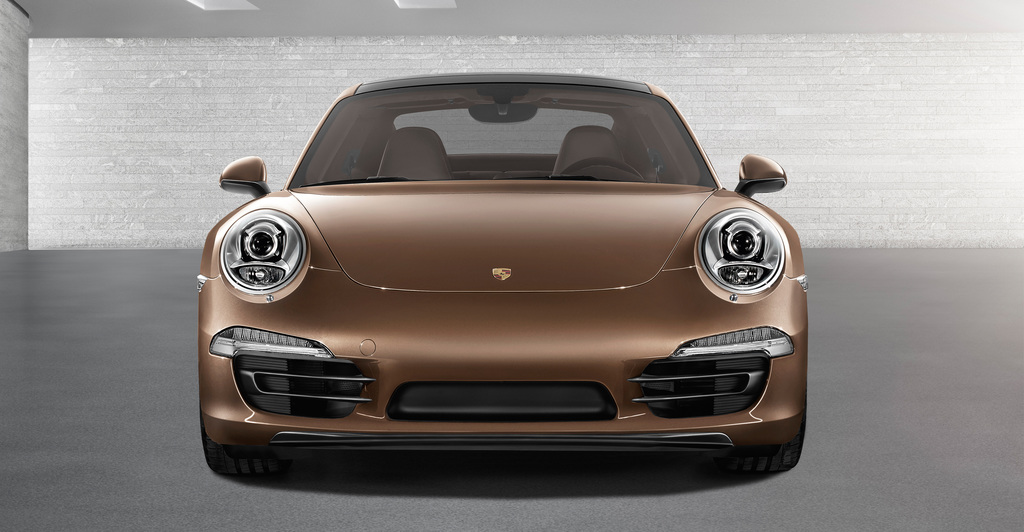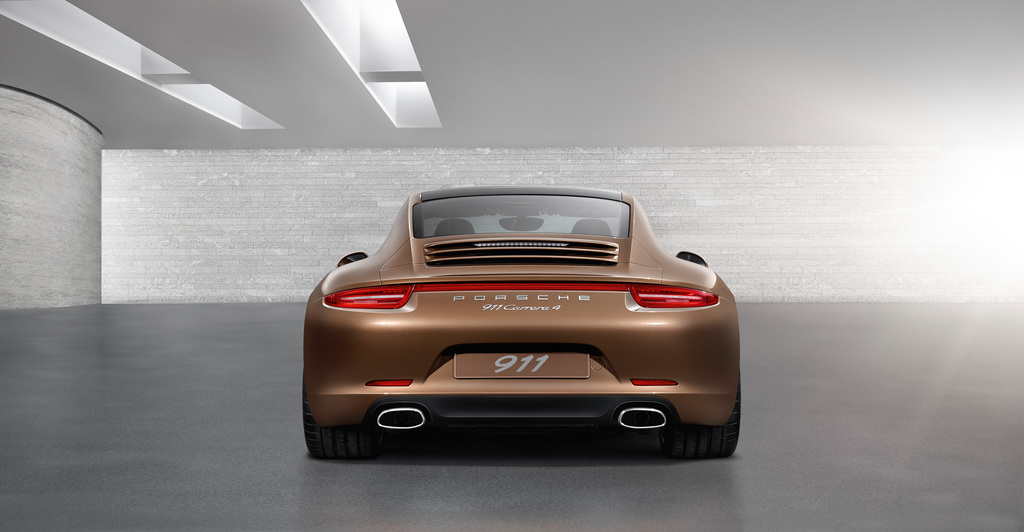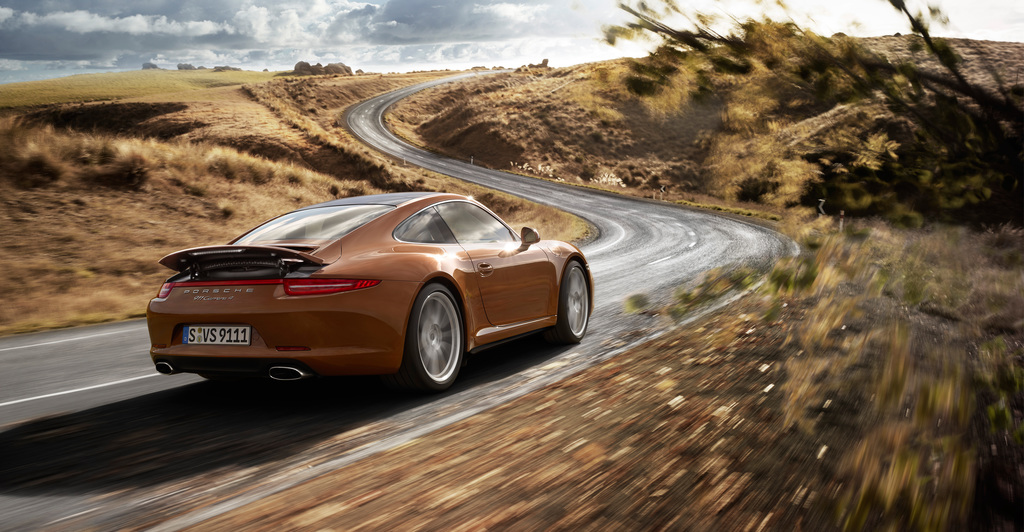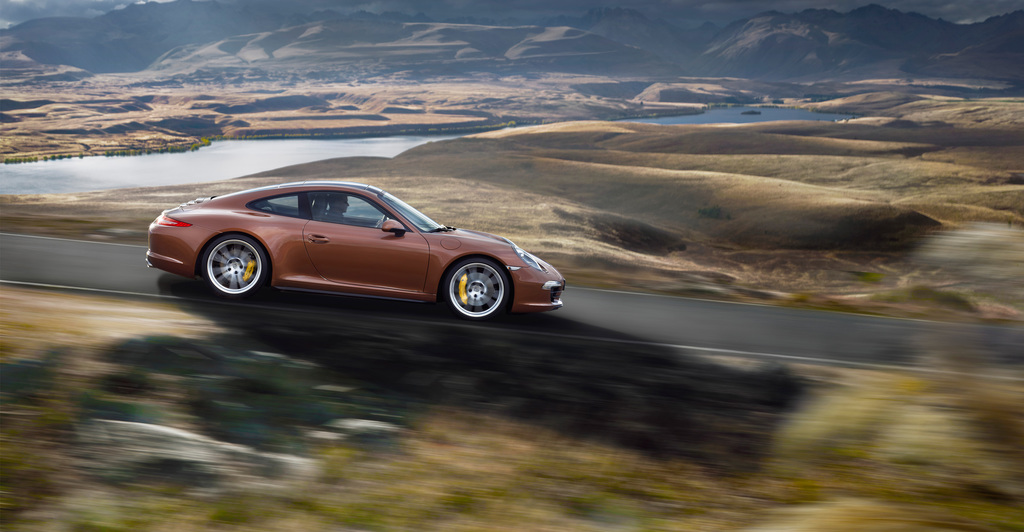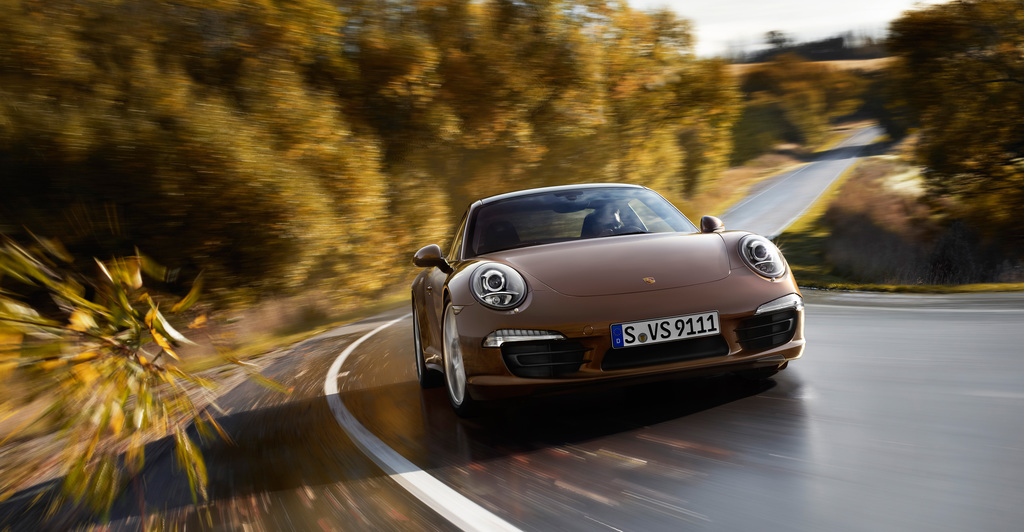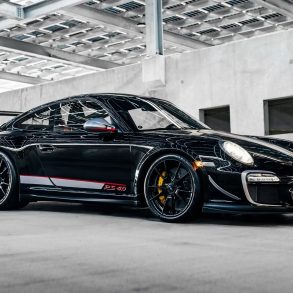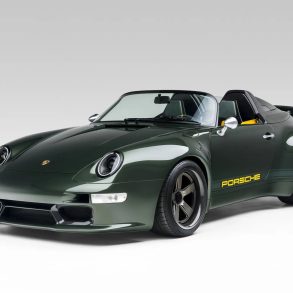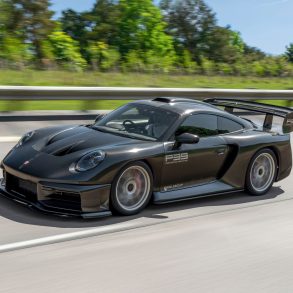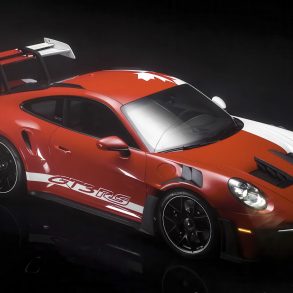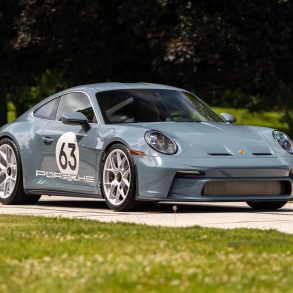(2013 – 2015) Porsche 911 Carrera 4 (991) – Ultimate Guide
The new Porsche 911 Carrera 4 unites the excellent performance and efficiency of the new generation of the 911 Carrera with the dynamic benefits of the latest version of the active all-wheel drive system PTM (Porsche Traction Management). The typical Porsche all-wheel drive with rear-focused layout in this latest 911 version guarantees maximum vehicle dynamics on a wide variety of road surfaces and in all weather conditions. The new 911 Carrera 4 models deliver traction and dynamic performance the power of four.
The new all-wheel drive 911 is being launched on the market in four versions – as the 911 Carrera 4 and 911 Carrera 4S and each as Coupé and Cabriolet. They sport the same traits as the rear-wheel drive versions: their lightweight body design, suspension, engines and gearboxes are identical, the only exception being modifications related to the all-wheel drive. This means that despite a higher level of engine and driving performance, all four models consume significantly less fuel than the previous models; total savings for individual versions are as much as 16 per cent. In addition, the new 911 Carrera 4 is up to 65 kg lighter in weight.
The most distinct identifying feature of the 911 with all-wheel drive is still the wide rear section: compared to the two-wheel drive 911 Carrera models, the rear wheel housings each extend further outward by 22 mm, and the rear tyres are each ten millimetres wider. The traditional red light band that connects the two taillights has also taken on a new form.
All new models have a 7-speed manual gearbox as standard, and the Porsche Doppelkupplung (PDK) gearbox is available as an option. The 911 Carrera 4 Coupé with 350 hp (257 kW) can sprint from zero to 100 km/h in as little as 4.5 seconds (Cabriolet: 4.7 s) and reach a top speed of up to 285 km/h (Cabriolet: 282 km/h), depending on equipment features. Fuel consumption with PDK is 8.6 l/100 km (CO2 203 g/km) for the Coupé and 8.7 l/100 km (CO2 205 g/km) for the Cabriolet.
The Coupé and Cabriolet of the 911 Carrera 4 S each have a 3.8-litre rear-mounted boxer engine that produces 400 hp (294 kW); this enables acceleration to 100 km/h in 4.1 seconds (Cabriolet: 4.3 seconds) and a top speed of 299 km/h (Cabriolet: 296 km/h) with a suitable equipment configuration. Fuel consumption values with PDK are 9.1 l/100 km (CO2 215 g/km) for the Coupé and 9.2 l/100 km (CO2 217 g/km) for the Cabriolet.
New: all-wheel drive indicator, Porsche Active Safe, sliding glass sunroof, extended Sport Chrono pack
In the new 911 Carrera 4, a new menu in the instrument cluster informs the driver how the PTM all-wheel drive is currently distributing engine power. In addition, with the debut of the 911 Carrera all-wheel drive models Porsche is introducing the optional Adaptive Cruise Control (ACC) to the entire model range, which controls distance to traffic ahead and vehicle speed. When ordered with PDK, the ACC system adds the safety function Porsche Active Safe (PAS), which helps to prevent front-end collisions. In addition, Porsche offers a new sliding glass sunroof as an optional feature for the 911 Carrera Coupé. Driving 911 cars with a manual gearbox and Sport Chrono pack can now be even sportier: In Sport Plus mode, the system automatically double-declutches during downshifts.
The new all-wheel drive models replace a very successful previous generation, of which a total of about 24,000 units have been sold since 2008. This represents a 34 per cent share of total sales of second generation 997 models. This previous generation launched with one of the greatest development steps in powertrain technology that the 911 with all-wheel drive ever made: new were the engines with direct petrol injection, Porsche Doppelkupplung (PDK) gearbox and electronically controlled Porsche Traction Management (PTM). In July 2011, Porsche crowned the model series with the 911 Carrera 4 GTS, whose 3.8-litre engine was boosted to 408 hp (300 kW).
Pictures
Press Release
The new Porsche 911 Carrera 4 unites the performance and efficiency of the new, seventh-generation of the 911 Carrera with the dynamic benefits of the latest version of the active all-wheel-drive system PTM (Porsche Traction Management). The typical Porsche all-wheel-drive system with focused rear bias in this latest 911 version promises maximum vehicle dynamics on a wide variety of road surfaces and in all weather conditions. The new 911 Carrera 4 models deliver traction and dynamic performance to the fourth power.
The new all-wheel-drive 911 is being launched in four versions – the 911 Carrera 4 and 911 Carrera 4S, each as Coupé and Cabriolet. They sport the same traits as the rear-wheel drive versions: their lightweight body design, suspension, engines and gearboxes are identical, the only exception being modifications related to the all-wheel-drive. This means that despite a higher level of engine and driving performance, all four models consume significantly less fuel than the previous models; total savings for individual versions are as much as 16 per cent. In addition, the new 911 Carrera 4 is up to 143 lbs. (65 kg) lighter in weight when compared to the previous generation 911 Carrera C4.
The most distinct identifying feature of the 911 with all-wheel drive is the wider rear section: compared to the two-wheel drive 911 Carrera models, the rear wheel housings each extend further outward by 22 mm for a total of 44 millimeters, and the rear tires are each ten millimeters wider. The traditional red light band that connects the two taillights on the 911 Carrera C4 has also taken on a new form.
Porsche Intelligent Performance: high levels of driving performance, low fuel consumption
All new models have a seven-speed manual gearbox as standard, and the Porsche Doppelkupplung (PDK) seven-speed gearbox is available as an option.
The 911 Carrera 4 Coupé with its 3.4-liter, 350 hp flat-six engine can sprint from zero to 60 mph in as little as 4.3 seconds (Cabriolet: 4.5 s) and reach a top-track speed of up to 177 mph (Cabriolet: 175 mph), depending on equipment features. Fuel consumption with PDK is EPA estimated at 20 mpg city / 28 mpg highway for the Coupé and EPA rated 20 mpg city / 27 mpg highway for the Cabriolet.
The Coupé and Cabriolet of the 911 Carrera 4 S each have a 3.8-liter rear-mounted boxer engine that produces 400 hp; this enables acceleration to 60 mph in 3.9 seconds (Cabriolet: 4.1 seconds) and a top-track speed of 185 mph (Cabriolet: 183 mph) with a suitable equipment configuration. Fuel consumption values with PDK are EPA estimated at 19 mpg city and 26 mpg highway for both the Coupé and the Cabriolet.
New: all-wheel drive indicator, Porsche Active Safe (PAS), sliding glass sunroof, extended Sport Chrono pack
In the new 911 Carrera 4, an additional menu in the instrument cluster informs the driver how the PTM all-wheel drive is currently distributing engine power. In addition, with the debut of the 911 Carrera all-wheel-drive models Porsche is making the optional Adaptive Cruise Control (ACC) available to the entire model range, which controls distance to traffic ahead and vehicle speed. When ordered with PDK, the ACC system adds the safety function Porsche Active Safe (PAS), which helps to prevent front-end collisions.
In addition, Porsche offers a new sliding glass sunroof as an optional feature for the 911 Carrera Coupé. Driving 911 cars with a manual gearbox and Sport Chrono pack can now be even sportier: In Sport Plus mode, the system automatically double-declutches during downshifts.
The new all-wheel drive models replace a very successful previous generation, of which 34 percent second-generation 997 models where all-wheel-drive. This previous generation launched with one of the greatest development steps in powertrain technology that the 911 ever made: new were the engines with direct fuel injection, Porsche Doppelkupplung (PDK) gearbox and electronically controlled Porsche Traction Management (PTM). In July 2011, Porsche crowned the model series with the 911 Carrera 4 GTS, whose 3.8-liter engine was boosted to 408 hp.
World premiere at the Paris International Motor Show
The new Porsche 911 Carrera with all-wheel-drive will make its first public appearance at the 2012 Paris International Motor Show September 29, 2012. The new 911 models will launch in the US early in 2013. The 2013 911 Carrera 4 will have a base MSRP of $91,030, and the 911 Carrera 4 Cabriolet base MSRP will be $102,930. The 911 Carrera 4S will have a base MSRP of $105,630 and the Cabriolet will have a base MSRP of $117,530.
###################
Porsche is doubling its range of driving fun in the new 911 generation by launching the all-wheel drive Porsche 911 Carrera 4 on the market in four model versions. The new sports cars with their uniquely powerful proportions combine the excellent traction and driving stability of the active Porsche Traction Management (PTM) system with the benefits of lightweight design, new engines and additional assistance systems – traction and dynamics to the fourth power.
Despite enhanced engine and driving performance, all four models consume significantly less fuel than their respective previous models; in some cases the savings add up to as much as 16 per cent. So, the new all-wheel drive 911 is consistently following the same course as the 911 Carrera Type 991 presented in 2011. The Carrera 4 takes top efficiency and performance to an even higher level.
The most distinctive identifying feature of the 911 with all-wheel drive is still the wide rear section: compared to the two-wheel drive 911 Carrera models, the wheel housings at the rear are each 22 mm wider, and each of the rear tyres is 10 mm wider. This increases the track width of the 911 Carrera 4 by 42 mm, and the track width of the S-model by 36 mm. The impressive look at the rear is highlighted by an exclusive tail-light panel with parking light and rear light functions. The tail-light panel runs directly under the spoiler edge and visually joins the two rear lights. For one, this emphasises the powerful back end of the vehicle; for another, it lends the all-wheel drive models a unique and very distinctive night design. When the lights are turned on, the illuminated rear light band visually connects the rear lights and signals that a new all-wheel drive 911 is driving ahead.
Indicator shows torque distribution: all-wheel drive made visible
In the new 911 Carrera 4, this special driving fun is being made visible for the first time: as a new standard feature, an indicator can be called up on the instrument cluster display that shows how the PTM all-wheel drive is distributing engine power. A bar indicator with ten segments per axle continually informs the driver of the drive torque available at the main transmission output as well as its current distribution to the front and rear axle.
New: ACC with Porsche Active Safe helps avoid front-end collisions
Making its debut in the 911 model series is the optional adaptive cruise control system with Porsche Active Safe (PAS) that is now being offered in Porsche 911 Carrera 4 models with PDK. Porsche Active Safe (PAS) supports driver attentiveness and warns drivers when they approach a vehicle ahead too quickly – even if the adaptive cruise control is deactivated. The system thereby helps to prevent front-end collisions, e.g. due to driver misperception of the speed of the vehicle ahead.
Change of generation: previous models set technological milestones
The new all-wheel drive models are replacing a very successful previous generation that has sold a total of about 24,000 units. This represents a 34 per cent share of second generation 997 models. In 2008, this generation introduced one of the greatest advances in powertrain technology ever made in the 911 with all-wheel drive: the cars offered engines with petrol direct injection, the Porsche Doppelkupplungsgetriebe (PDK) and the electronically controlled Porsche Traction Management (PTM). In July 2011, Porsche crowned the model series with the 911 Carrera 4 GTS, whose 3.8-litre engine was performance enhanced to 408 hp (300 kW).
All-wheel drive
The new all-wheel drive 911 cars are equipped with the latest generation of Porsche Traction Management (PTM). It is based on the system of the 911 Turbo, Type 997 and was especially optimised in its control strategy with a special focus on improving efficiency and fuel economy.
As a result, PTM now supports the typical Porsche coasting function of the 911 equipped with PDK. If the vehicle is coasting without drive power, the PTM clutch is opened. This reduces the braking torque of the all-wheel drive system, which in turn improves fuel economy.
Engine and transmission
With the generation change, the all-wheel drive models of the 911 Carrera now have new engines with 3.4 litres and 3.8 litres of engine displacement.
To increase their efficiency, the boxer engines feature electrical system recuperation and map-controlled coolant thermal management. Other measures that improve fuel economy are friction minimising actions in engine design, reduced rolling resistance with new generation tyres and the introduction of electro-mechanical power steering.
The principle of only calling up engine power when it is actually needed has led to a new feature for sports cars in the new 911 cars with PDK: coasting. In this case, the term refers to coasting without any engine propulsion, which enables idling fuel consumption over specific segments of the driving route. In practical terms, this results in fuel savings of up to one litre per 100 km with an anticipatory style of driving in everyday operation.
Sound Symposer intensifies acoustic driving fun
The new generation Porsche 911 Carrera also offers the driver even sportier driving fun in its acoustics. The Sound Symposer – a standard feature in all models – produces an even more full-bodied and sporty engine sound in the interior and is operated by the standard Sport or optional Sport Plus control button.
Sport exhaust system boosts power and enjoyment
A sport exhaust system is also available as an option for the new all-wheel drive models. It not only dethrottles the exhaust at the press of a button, but also merges the two exhaust lines. Pressing the sport exhaust system button on the centre console gives the six-cylinder boxer engine a more full-bodied sound paired with optimal performance. The acoustical effect offers even more emotional appeal, especially since the sound symposer flap is simultaneously activated. The sport exhaust system is visually distinguished by two twin tailpipes with unique styling.
Transmissions: seven speeds for dynamics and efficiency
The Porsche strategy for realising efficient performance includes two transmissions that deliver uncompromising sportiness as well as long gear ratios that improve fuel economy: the world’s first seven-speed manual gearbox in passenger car production and the Porsche Doppelkupplungsgetriebe (PDK), which also has seven gears. This means that drivers of the 911 Carrera with a manual gearbox can enjoy the same fuel economy advantages that the PDK is known to deliver: up to 19 per cent lower revs at the same vehicle speeds, which improves fuel economy by up to ten per cent in constant speed driving.
Chassis and control systems
In developing the new 911 Carrera generation, preparations were already made in tuning the chassis for the additional driving of the front wheels in the new all-wheel drive 911. That explains why the vehicle is largely based on the rear-wheel drive version. A significant exception is the wider track of the rear axle. Together with PTM all-wheel drive, this offers even higher stability in bends, even with powerful acceleration.
As in all 911 models, the longer wheelbase – lengthened by 100 mm compared to the previous model – provides for significantly better driving stability at high speeds. Other systems that guarantee top driving performance – some standard and some optional depending on the model – are the further advanced Porsche Active Suspension Management (PASM), dynamic engine mounts, Porsche Dynamic Chassis Control (PDCC), innovative electro-mechanical power steering, Porsche Torque Vectoring (PTV), a high-performance brake system and the car’s wheels and tyres.
PASM sport chassis with downforce at the rear axle
The PASM sport chassis – which sports a ride height lowered by 20 mm and an aerodynamic package – is also offered in the new Porsche 911 Carrera 4 models. This aerodynamic tuning results in less lift at the front axle and even provides downforce at the rear axle. In sum, the lift is zero. As a result, a 911 Carrera 4 with PASM sport chassis delivers exceptionally good road contact at high speeds and reacts very spontaneously and directly to steering inputs.
Driving through a bend faster and safer: Porsche Torque Vectoring
Offering even further enhanced agility in the new 911 cars is Porsche Torque Vectoring (PTV), which is standard in the Porsche 911 Carrera 4S and is available as an option in the Porsche 911 Carrera 4. There are two versions of the system: PTV with mechanically locking differential for cars with a manual gearbox and PTV Plus with electronically controlled, fully variable differential lock for PDK vehicles. Essentially, when driving through a bend PTV/PTV Plus uses specific brake interventions at the inside rear wheel to improve agility and steering precision with a highly dynamic style of driving, and the differential lock improves the car’s acceleration potential coming out of a bend.
Even sportier at the press of a button: from Sport button to Sport Chrono package
All 911 Carrera cars already have a Sport button as standard. It lets the driver choose tuning optimised for comfort and fuel economy or tuning that emphasises sporty performance. The optional Sport Chrono package with the additional Sport Plus button enables an even wider spread between sporty tuning and ride comfort in everyday driving. Besides configuring all relevant systems and functions for maximum performance, the Sport Chrono package also has controlled dynamic engine mounts.
New in the Sport Chrono package: downshifting with double declutching
The Sport Chrono package includes an analogue and digital chronometer; the optional PCM also has a performance indicator with memory function. Another new feature of the optional Sport Chrono package is that for vehicles with a manual gearbox it has been extended to automatically double declutch during downshifts in Sport Plus mode. In quick shifting, this better adapts engine speed to the lower gear, letting the driver utilise the engine’s power or braking ability more effectively.
Porsche Dynamic Chassis Control for impressive performance gains
Making a decisive contribution towards impressive performance gains in the new 911 generation is Porsche Dynamic Chassis Control (PDCC) – an optional feature of the Porsche 911 Carrera 4S. With this system, the 911 attains a new level in terms of lateral acceleration and handling. Body roll of the vehicle is nearly fully compensated by the variable stabiliser system up to maximum lateral acceleration, e.g. when steering into a bend, driving through a bend or quickly changing lanes. Because of the reduced roll angles, the tyres are always optimally aligned to the road surface, so that they can transmit maximum force in any direction. This boosts potential vehicle speeds when driving through bends.
Body and roof
The innovative lightweight body of the new 911 Carrera range was developed for top driving characteristics in both the Coupé and Cabriolet – and for rear-wheel and all-wheel drive versions – with just minor modifications.
All models share the weight advantages of the aluminium-steel construction with substantially improved rigidity, supplemented by local reinforcement elements in the soft-top 911s. The new 911 Carrera cars with all-wheel drive are up to 65 kg lighter than previous models.
911 Cabriolet: unique fabric roof with coupé properties
An eye-catching feature of the soft-top all-wheel drive 911 cars is the panel bow top – a new development by Porsche. This innovative technology has succeeded in creating a previously unattainable coupé-like roof arch of the soft top when it is up, and this leads to aerodynamic advantages as well. In addition, the weight of the entire top nearly matches that of the previous model, despite being longer and offering significantly improved comfort. Another innovation in all soft-top 911 Carrera cars is the integrated and electrically deployed wind deflector. Installing and removing it are now a thing of the past.
Interior and features
The interior of the new all-wheel drive 911 cars that is making its appearance is based on the new generation concept. The central design element is the centre console that rises towards the front. It provides excellent ergonomics that integrate both the driver and front passenger.
The operating concept permits uncomplicated and intuitive control of key vehicle functions. Already equipped with standard features that are extensive and high-end, the new 911 Carrera 4 cars can be customised to a wide variety of individual tastes with an extensive list of options.
Sport seats for dynamic driving and long trips
The defining interior element of all 911 Carrera cars is the standard sport seat system with electrically adjustable backrest angle and seat height. The optional sport seats with fully electric 14-way adjustment add – in addition to adjustments of the standard seats – electric adjustment of the longitudinal position, seat cushion angle, seat cushion depth and four-way lumbar support. The Sport Seat Plus option that is also available offers 18-way adjustment and more prominent side supports; it also offers adjustment of the side supports on the seat and backrest for optimal lateral support in all driving situations.
New: lightweight sport shell seats made of fibre-reinforced polymer
For 911 Carrera drivers with very sporty performance standards, Porsche offers new especially lightweight sport shell seats with folding backrests, integrated thorax airbag and manual longitudinal adjustment. The seat shell is made of glass-reinforced and carbon-reinforced polymer with a visible carbon surface. A special feature is the pivot point of the backrests, which lies high in the side supports. The lateral support that is characteristic of race car shell seats is thereby also assured in the pelvic area. However, the folding backrest still enables convenient loading of the luggage compartment in the rear.
Specifications
Porsche 911 Carrera 4
3.4-litre boxer engine with 350 hp (257 kW)
7-speed manual gearbox, optional 7-speed Porsche Doppelkupplungsgetriebe (PDK)
Active all-wheel drive Porsche Traction Management (PTM)
0-100 km/h: 4.9 seconds (PDK: 4.7 seconds; Sport Chrono: 4.5 seconds)
Top speed: 285 km/h (PDK: 283 km/h)
Fuel consumption (NEDC): 9.3 l/100 km, CO2 219 g/km (PDK: 8.6 l/100 km, CO2 203 g/km)
Porsche 911 Carrera 4 Cabriolet
3.4-litre boxer engine with 350 hp (257 kW)
7-speed manual gearbox, optional PDK
Active all-wheel drive Porsche Traction Management (PTM)
0-100 km/h in 5.1 seconds (PDK: 4.9 seconds; Sport Chrono: 4.7 seconds)
Top speed: 282 km/h, (PDK: 280 km/h)
Fuel consumption (NEDC): 9.5 l/100 km, CO2 224 g/km (PDK: 8.7 l/100 km, CO2 205 g/km)
Porsche 911 Carrera 4S
3.8-litre boxer engine with 400 hp (294 kW)
7-speed manual gearbox, optional PDK
Active all-wheel drive Porsche Traction Management (PTM)
0-100 km/h in 4.5 seconds (PDK: 4.3 seconds; Sport Chrono: 4.1 seconds)
Top speed: 299 km/h, (PDK: 297 km/h)
Fuel consumption (NEDC): 9.9 l/100 km, CO2 234 g/km (PDK: 9.1 l/100 km, CO2 215 g/km)
Porsche 911 Carrera 4S Cabriolet
3.8-litre boxer engine with 400 hp (294 kW)
7-speed manual gearbox, optional PDK
Active all-wheel drive Porsche Traction Management (PTM)
0-100 km/h in 4.7 seconds (PDK: 4.5 seconds Sport Chrono: 4.3)
Top speed: 296 km/h, (PDK: 294 km/h)
Fuel consumption (NEDC): 10.0 l/100 km, CO2 236 g/km (PDK: 9.2 l/100 km, CO2 217 g/km)


